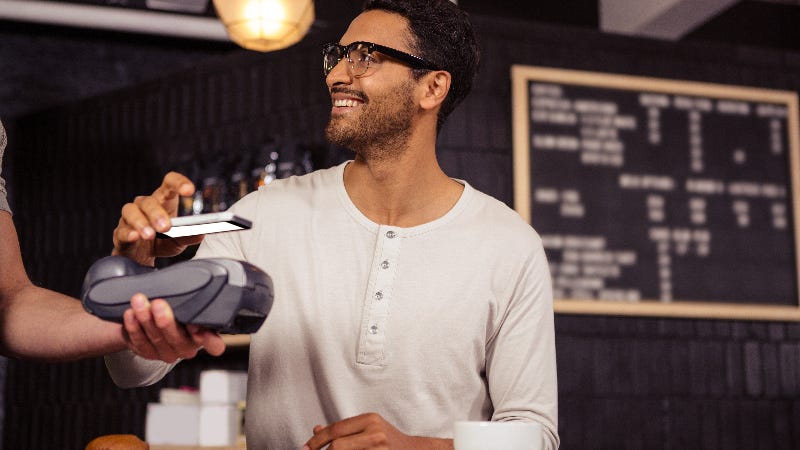Safest ways to pay in 2023 and beyond

Cybercrime is definitely on the rise, and many troubling criminal acts center around in-person and online payment methods as well as general identity theft. In fact, a 2022 study on identity fraud from Javelin Strategy & Research revealed that this type of fraud remains one of the fastest growing criminal enterprises to date, and that combined identity fraud scam losses amounted to $28 billion in 2021.
In December 2022, Nilson Report also forecasted that U.S. losses from card fraud will total $165.1 billion over the next ten years. Meanwhile, Insider Intelligence noted that “card-not-present” payments, including online transactions, make up the lion’s share of fraudulent transactions facilitated by credit cards each year.
But that doesn’t mean you can’t still do your best to ensure your purchases are secure when shopping in a store or browsing the web. The good news is, there are plenty of in-person and online payment methods that have the technology and features to keep your personal information safe.
Secure online payment methods
If you’re hoping to make your transactions as secure as possible when you shop online in 2023, consider the following online payment methods.
Credit cards
By and large, credit cards are easily the most secure and safe payment method to use when you shop online. Credit cards use online security features like encryption and fraud monitoring to keep your accounts and personal information safe. Most issuers also offer zero fraud liability to ensure you won’t be on the hook for a cent for fraudulent transactions charged to your credit card.
Beyond the zero fraud liability coverage credit cards offer, you can only be legally liable for up to $50 in fraudulent charges on a credit card due to the Fair Credit Billing Act (FCBA). This means that, even if a hacker or thief gets ahold of your credit card number, you won’t be on the hook for more than $50 in purchases they make, regardless of how much they spend.
ACH payments
Automated Clearing House (ACH) payments let you transfer funds directly from your checking account to another bank account. This payment network adheres to plenty of security features that keep your banking information safe, such as encryption and the implementation of access controls.
Stored payment credentials
According to the 2022 How We Pay Digitally study by PYMNTS, 80 percent of online shoppers used stored payment credentials in various online accounts in order to make online purchases throughout 2022. Meanwhile, consumers were more likely to pay for purchases with a stored debit card or credit card versus stored bank account information last year.
If you want purchases made with stored payment information to be more secure, you should set up a credit card with zero fraud liability as your preferred method of payment.
Secure in-person payment methods
Technology has also made in-person payments more secure than ever, especially for payments using a mobile device. The following in-person payment methods boast increased security features that help protect your personal information.
Credit cards with EMV chip technology
Where you once had to swipe your credit card to make an in-person payment, most credit cards today feature EMV chip technology instead of a magnetic strip. With EMV technology, the payment terminal reads your card for the unique, encrypted information transmitted by the chip on your card. Since the single-use encrypted information is different for each transaction, this technology helps to eliminate counterfeit fraud.
EMV technology has expanded rapidly over the last decade, both in the U.S. and around the world. According to standards body EMVCo, more than nine in 10 (91.4 percent) of card-present transactions worldwide were made using EMV-chip-enabled payment cards as of Q2 2022.
Credit cards with contactless payment
Contactless payments use the same technology as EMV chip and pin credit cards. With a credit card that allows contactless payments, you’ll hold your card above the payment terminal and the terminal will receive an encrypted, one-time use code for the transaction.
Before COVID-19 entered our lives in 2020, contactless payments were already on the rise. However, this trend has only increased since the start of the pandemic and continues to grow in popularity.
Payment apps
Payment apps like PayPal, Google Pay, Apple Pay and Facebook Pay let you store multiple payment methods in one place for convenience and security. With a payment app, you can benefit from features like multi-factor authentication, notifications and even facial or fingerprint recognition.
With Apple Pay, for example, you have to have a passcode on your device, but you can also set up Face ID or Touch ID. Apple Pay also doesn’t actually store or have access to your payment information, and they don’t retain any transaction information that can be tied back to you later on.
Payment methods to avoid
While every type of payment method has some disadvantages, debit cards are probably the riskiest form of payment. Debit cards do offer the convenience of a card, since you don’t have to carry cash around or write a check, but the funds you use are actually tied to your bank account.
Unlike credit cards that typically come with zero fraud liability and limit you to $50 in losses per the FCBA, debit cards only limit you to $50 in losses if you report the fraud to your account within two business days after you noticed it.
- If you report fraud more than two business days but less than 60 calendar days after your statement is sent to you, you could be on the hook for up to $500 in fraudulent charges.
- If you don’t report card fraud for 60 or more days after your statement is sent to you, you could lose “all the money taken from your ATM/debit card account, and possibly more; for example, money in accounts linked to your debit account,” according to the Federal Trade Commission (FTC).
Ultimately, this means making purchases with a debit card online or in-person could put your personal funds at risk.







